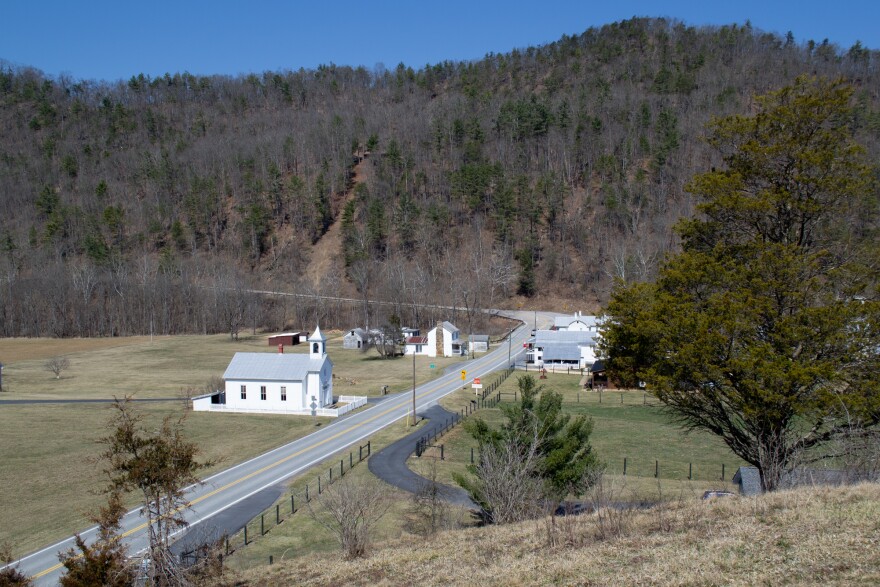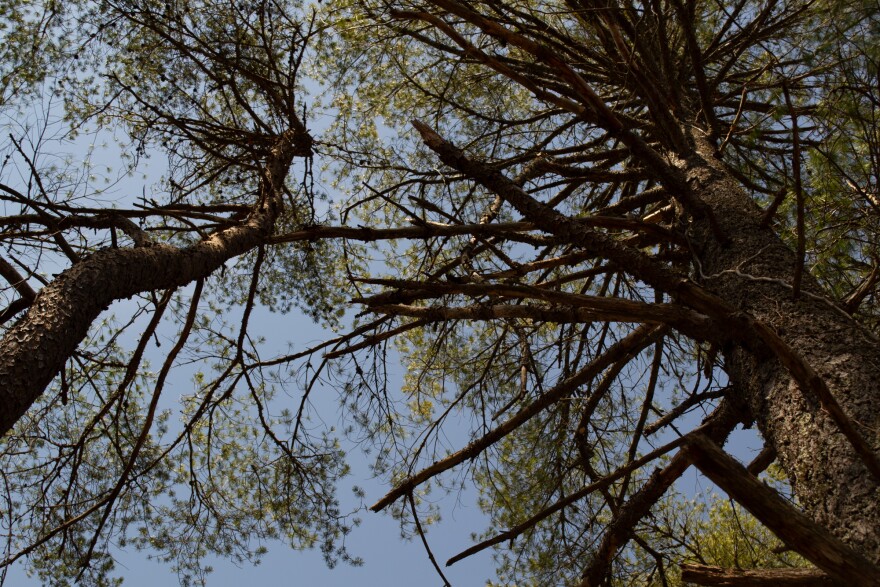One local researcher has documented more than 11,000 graves in Highland County and the surrounding areas – uncovering tales of intrigue, tragedy, and joy. WMRA's Randi B. Hagi reports.
[sounds of walking through leaves, birdsong]
On a steep hillside tumbling down to Shaws Fork in Highland County, gravestones rise up like rocky sentinels above a ribbon of farmland. Some of the graves in the Hodge-McCray cemetery have inscribed headstones. One sprouts a Confederate Army marker. Others just have bare rocks bookmarking someone's final resting place.

KENT BOTKIN: My father's homeplace that we used to own is up here, up toward the end of the fork.
Kent Botkin's family is from here, around the little community of Head Waters. His mother's mother's first husband was a Hodge.
BOTKIN: They had three children. One lived, the other two died in infancy, and they are buried here. And he got a job in Pocahontas County, cutting timber, which was where a lot of men from Highland went to get work. And a tree fell on him.
He reads from Charles Hodge's 1916 obituary in the Highland Recorder.
BOTKIN: And at the end it says, "thus, the lumber camps augment their long list of Highland victims – dead, crippled, widowed, and orphaned."
When he's not at his day job at Green Valley Auctions, Botkin is often out documenting burial sites and scouring old newspapers and vital records for evidence of the people interred there. Over the past dozen years, he's recorded details from over 11,000 graves on the website FindAGrave.com. That's where I first came across his work, when I was researching the Cabell family of Staunton's historic Cabell Log House.
BOTKIN: My father and some of the older people of Highland County told me little stories about various people, and I was looking for a way to preserve that and document it. … When I was doing mine, it was like, well here is this person here and there's no family left to document, record what they did.
His labor of love grew from there. So far, he's visited 198 burial sites in Highland County, and more in Augusta and Bath, and West Virginia's Pendleton and Pocahontas counties. The oldest date back to the 1790s. The most remote –
BOTKIN: You can only get there by foot. You've got to cross a river, climb a couple steep hills.
In the middle of a cow field in Head Waters is a community cemetery where just over 400 people are buried – the descendants of Scotch-Irish and German immigrants who lived in the mountains.

One of them is James Carwell, the onetime owner of The Hotel Monterey. Misfortune befell James and his wife Amanda, starting with a fire that temporarily closed the hotel.
BOTKIN: And then in January of 1920, she dies of food poisoning … and then he disappears in March 1921, with a wad of cash and a pistol … and then later that year, they find his body outside of Monterey, with a bullet hole in his skull – in the back. … The cash is gone. … They couldn't find the pistol. … It's still an unsolved mystery. … It's kind of hard to shoot yourself in the back of the head and get rid of the gun at the same time.
Many of Botkin's relatives are here, too, including his great-aunt "Lou" McCray.
BOTKIN: Lou was very musical. She and my grandmother, both of them played the organ for the Presbyterian church down here. … My grandmother was a very conservative kind of person. Lou was a very free-spirited person. They both played the organ, and they'd both sit up there, and the church congregation would have to wait while the two women debated on who played what!

Just down Route 250 towards McDowell, on a secluded little knoll dotted with sun-warmed pines, is another burial site. Only one of the plots has an engraved headstone.
BOTKIN: And if you notice, there's a whole bunch of graves through here. …
HAGI: They're like these little pockets in the hillside.
BOTKIN: Yeah, so there's one there. … I think there's between 15 and 20 graves here, for sure.

The one man we know for sure is buried there is George William Allen Minor, a Black World War I veteran. Based on genealogy records, he was born in Highland County to George and Bettie Jackson Rodgers Minor in 1896. Minor served overseas in the 867th Company of the Transportation Corps. A passenger list notes that he sailed back to the U.S. from Bordeaux, France in 1919.

He returned to Highland County to farm before moving to the Staunton area, where he worked at a military school. He died three days after Christmas, 1934, of "gastrointestinal toxemia" from eating canned meat. He was 38 years old. Minor's obituary says he was survived by his wife, Lelia, his mother, three brothers, two stepdaughters, and three grandchildren. He was buried in the "Jackson cemetery near McDowell," indicating that the others buried there are likely his mother's kin.
One of his stepdaughters, Margaret, moved to Baltimore. I've tried to contact some of her descendants but have not heard back. We also spoke with members of the Staunton Augusta County African American Research Society and the Augusta County Historical Society but were not able to find any local relatives.
BOTKIN: There is an American flag by the soldier's grave, so somebody's been up here in the last few years to honor him in that way.

Botkin found out about this cemetery from a book called "Vital Records of Highland County, Virginia," published by John and Emma Matheny in 1986. The Matheny's describe it as "just west of Old Squire Wilson's farm," where there was one other marked headstone – for a "Bob Jackson" who died in 1928.
BOTKIN: When this was recorded, his headstone read, "A Faithful Servant." … Well, if it was a homemade one, it may have disintegrated. I have not been able to find his headstone.
This man was likely George Minor's great-uncle, Andrew Jackson. Jackson was born 11 years before the end of the Civil War, and is listed as a child in census records as a free resident of Bath County. He was deaf from a young age if not birth. One of his sisters, Nancy Jackson, appears to be Minor's maternal grandmother. Andrew went to work for Squire W. and Minnie Wilson as a farmhand and servant for decades. He died in his 70s, of heart problems.
BOTKIN: The markers for the other graves are sinking into the ground, and … it's a shame that there's no way to make it more permanent. At least on the internet there is some record of it, and hopefully, later on down the line, somebody will come along and find that information and find it useful.
Until then, the interred keep their silent vigil under the pines – another family laid to rest in the Virginia mountains they called home, remembered by researchers and what descendants time has scattered to the wind.
Editor's note, April 25 — a previous version of the audio for this story included the erroneous note that Andrew Jackson moved with the Wilsons to Harrisonburg before returning to Highland County. Upon further inspection of Ancestry.com records, it appears that the trio stayed in Highland County. The audio has been updated.



